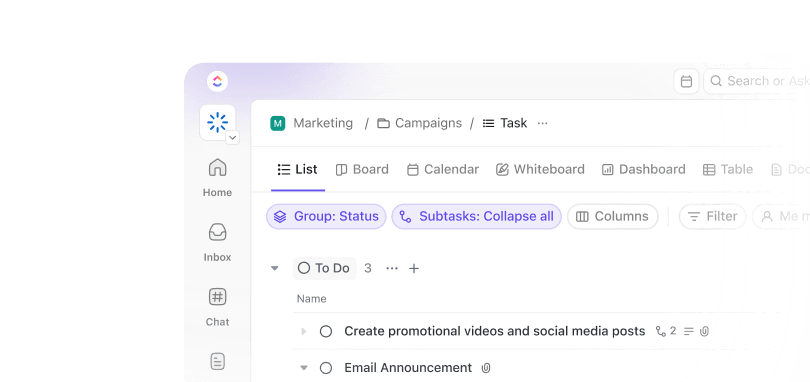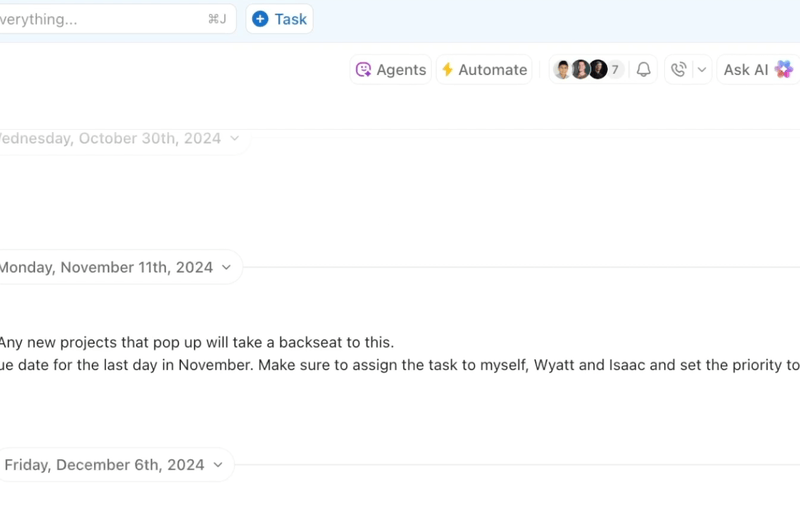Imagine a world where AI doesn’t just follow instructions but actively works toward achieving goals—intelligently adapting, planning, and learning in real time.
This isn’t a glimpse of the future; it’s happening now with goal-based agents. These smart systems use AI and machine learning to adapt, plan, and act with a singular focus: achieving specific goals.
Whether it’s tackling complex challenges or optimizing daily tasks, goal-based agents are leading the next wave of AI innovation. From tools like Brain—’s AI-powered assistant that helps teams set clear goals, track progress, automate tasks, and make smarter decisions—to self-driving cars and robotics, these agents transform how we live and work.
Read on as we explore how these systems transform our lives and work. 🤖
Goal-Based Agent in AI: Optimizing Systems & Driving Innovation
⏰ 60-Second Summary:
- Goal-based agents are intelligent systems that deliver specific results using the plan-act-adapt cycle
- They improve decision-making, drive productivity, and optimize resource utilization across different applications like robotics, self-driving cars, generative AI, and project management
- Key types include simple reflex agents, model-based agents, utility-based agents, and hybrid agents
- While challenges revolving around data quality and potential bias exist, they offer immense potential in helping businesses achieve their goals
- Popular examples of goal-based agents include Brain, Roomba, Tesla self-driving cars, ChatGPT, and Amazon Robotics
What is a Goal-Based AI Agent?
Goal-based agents belong to a larger category of intelligent agents—systems capable of analyzing their environment and taking goal-oriented actions to achieve desired outcomes. Acting as model-based agents, they can adapt during execution to ensure greater flexibility and success.
While simple reflex agents act on immediate inputs without considering the future state, goal-based AI agents focus on achieving well-defined agent aims. This makes them powerful tools for managing complex environments that require continuous adaptation.
For example, a model-based agent uses internal models to simulate and predict future states, allowing it to make more strategic decisions based on expected outcomes. Meanwhile, a utility-based agent leverages utility function maps to evaluate various options and choose the most beneficial course of action, optimizing for long-term success.
This makes goal-based agents essential for solving workplace challenges where dynamic conditions demand constant adjustments and strategic planning.
Characteristics of a goal-based AI agent
Key traits of goal-based AI agents include:
- Goal-driven decision-making – Prioritizes actions based on long-term objectives rather than short-term results
- Strategic planning – Evaluates multiple pathways and future scenarios to determine the most effective course of action
- Adaptive learning – Adjusts in real time based on new inputs and changing conditions
- Resource optimization – Minimizes waste and enhances efficiency in decision-making
- Error management – Anticipates potential issues and applies self-correction strategies to improve reliability
- Enhanced user experience – Personalizes interactions to improve engagement and effectiveness
How Leverages Goal-Based AI
In this regard, —the everything app for work—integrates goal-based AI through features like Brain, Meeting Notetaker, and AI Agents to help you achieve more efficiently and effectively.
- First, Goals help you set SMART (Specific, Measurable, Achievable, Relevant, and Time-Bound) goals. By defining qualitative and quantitative goals, you can easily track progress and stay focused
- Next, Tasks break down larger goals into actionable and manageable steps, allowing you to manage deadlines, prioritize work, and assign responsibilities
- With Dashboards, you gain a visual representation of your progress, enabling you to identify bottlenecks and proactively plan for setbacks. These dashboards provide data-driven insights, allowing you to make informed decisions and adjust your strategy
- Brain powers a new layer of goal-based intelligence—AI Agents. These agents can plan, act, and adapt in real-time to support your goals. From helping you reprioritize tasks to triggering next steps based on progress updates, AI Agents operate like autonomous assistants that take work off your plate while keeping projects aligned
Meet AI Agents: Goal-Driven Automation at Work
AI Agents are intelligent assistants built into your workspace to help you move from goal-setting to execution—faster and smarter. Unlike basic automations, these agents don’t just react—they plan, act, and adapt based on your goals, context, and evolving workflows.
For example, when you create a task like “How to market on Reddit,” AI Agents jump into action automatically. They summarize the task, identify related goals, generate relevant subtasks, and suggest similar resources—without you having to lift a finger.
This is goal-based AI in action: the agent understands the task’s purpose, cross-references similar entries across your workspace, and provides next-best actions that align with your marketing objective.

AI Agents can:
- Generate subtasks or project plans based on the task’s goal or title
- Recommend similar work, documents, or resources automatically
- Summarize what needs to be done and notify you with updates
- Work in tandem with Brain to provide intelligent suggestions
🧐 Did You Know? These AI agents continuously learn from how you and your team interact with . Over time, they become more aligned with your workflows, decision-making preferences, and strategic goals—making them indispensable allies for project execution.
💡 Using AI daily? Brain Max gives you talk-to-text, voice input, and desktop access so you can ask, assign, or update tasks hands-free—making AI agents even more natural to use in the flow of work.
Types of Goal-Based Agents
Although all goal-based agents share the core characteristics mentioned earlier, their approaches and applications vary.
Here’s a comparison of the different types of goal-based AI agents:
| Type of goal-based AI agents | Focus | Key features | Strengths | Limitations | Examples |
| Reactive agent | Instant response | Responds to stimuli directly. No internal model | Quick response and simple implementation | Possesses limited reasoning and cannot handle complex goals | Basic robots like Roomba, which respond to obstacles |
| Deliberative agent | Long-term planning | Focuses on planning and reasoning. Uses world model | Capable of complex, goal-oriented behavior and considers future actions | Computationally intensive and makes decisions slowly | Self-driving cars planning safe routes |
| Hybrid agent | Combination of reactive and deliberative agent | Combines reactive responses with long-term planning | Balances quick responses with long-term planning | May conflict in decision layers and encounter complexity in coordination | Autonomous drones that respond to immediate obstacles while following a planned path |
Importance of Goal-Based Agents
Regardless of the industry, goal-based agents drive efficiency, accuracy, and innovation.
Here’s a breakdown of their significance:
- Enhancing decision-making: Evaluating all potential actions and outcomes to ensure alignment with overarching goals for optimal results with AI-powered decision-making, even in complex scenarios
- Integrating with intelligent systems: Enabling coordinated actions and comprehensive solutions to improve overall ecosystem performance
- Optimizing resource management: Dynamically allocating time, staffing, technology, and materials to minimize waste and maximize productivity
- Facilitating collaboration: Streamlining teamwork, leveraging AI for efficiency, and aligning team objectives with broader organizational goals
- Personalizing user experience: Adapting interactions to evolving needs while maintaining effectiveness and intuitiveness
- Enabling proactive decision-making: Anticipating challenges and opportunities through predictive analytics to shift from reactive to proactive responses
- Scaling across industries: Expanding applicability across sectors such as healthcare, finance, and construction
- Driving innovation: Automating tasks with AI and optimizing workflows to free human resources for creative and strategic initiatives
Task prioritization with
With , you can prioritize tasks using custom tags and priority levels like urgent, high, normal, or low to organize workflows and meet critical deadlines.
This way, it:
- Ensures critical tasks are easily identified and addressed first
- Enables better time management by allowing you to focus on high-priority wor
- Optimizes workflows by clearly differentiating between various task urgencies
- Enhances team collaboration by setting clear expectations for task timelines and importance
- Reduces the risk of missing important deadlines by visualizing priority levels clearly
💡 Pro Tip: AI Agents can help you automatically reprioritize work based on shifting project timelines or capacity changes—saving time and reducing manual updates.
Moreover, Goals help you stay focused on achieving your objectives by providing clear timelines, measurable milestones, and automatic progress tracking.
This feature allows you to break your goals into smaller, actionable tasks, set deadlines, and track real-time progress. This ensures that you consistently meet your targets and stay on course to achieve your desired outcomes while allowing you to adjust your plans to stay aligned with your goals.
🔎 Did you know? Goal-based agents are the foundational unit of smart homes. Seeing how nearly 80% of home buyers would pay extra for a smart home, goal-based agents are a channel for untapped revenue.
How Goal-Based Agents Work
Goal-based agents operate through a series of interconnected stages, each contributing to their efficiency and adaptability.
Here’s an overview of how they work:
1. Goals, planning, and execution
Every goal-based agent program operates on a specific agent function. Based on this, they develop comprehensive plans that further break down into tasks and actionable steps arranged in an optimal sequence. This forms the baseline of the most efficient path to reach desirable situations.
2. Perception and action selection
AI agents thrive in dynamic conditions because of their perceived intelligence. They monitor environmental changes and run multiple scenarios to identify and perform actions aligning with the goal. This allows them to recover from errors and disruptions. Such informed decision-making neutralizes uncertainties and fuels progress.
3. Resource allocation and prioritization
AI-based agent programs govern resource allocation tools, assigning resources and prioritizing actions based on their impact on goal achievement. This ensures efficiency, eliminates bottlenecks, and minimizes resource competition regardless of the intended path or subsequent modifications.
4. Continuous feedback loops
As a product of artificial intelligence and machine learning, goal-based rational agents use feedback mechanisms to learn and improve over time. This empowers them to refine strategies and make smarter decisions in subsequent iterations to enhance efficiency and effectiveness.
Applications of Goal-Based Agents
Goal-based agents are in high demand across different domains and industries. Some of these include:
1. Generative AI
Generative AI trains natural language engines to create outputs aligned with specific goals. From replicating art styles to crafting ad copy, it generates relevant, purpose-driven content.
Brain is a prime example of how generative AI enhances productivity by offering smart recommendations and automated task management. It integrates seamlessly into workflows, assisting users with decision-making, prioritization, and task optimization.


By learning from user interactions, Brain adapts and refines its suggestions, helping teams stay focused on their goals and achieve better results efficiently.
💡 Pro Tip: These suggestions can be turned into automated actions with AI Agents—like turning a generated meeting summary into assigned next steps instantly.
2. Automation
Goal-based AI agents transform automation by optimizing tasks, tracking goals, enhancing precision, and enabling autonomous operations.
These agents are designed to pursue specific goals and handle complex tasks with minimal human intervention.
An example of automation in business operations would be goal-based AI agents autonomously managing customer service, optimizing workflows, and streamlining supply chain processes.
In , AI Agents can be deployed to monitor task progress, adjust timelines, and initiate follow-ups—bringing human-like adaptability to automation.
The Robotic Process Automation RFP Template simplifies defining automation needs and comparing vendors. It ensures businesses can quickly align solutions with their goals, facilitating more informed decisions. By using the template, teams can streamline their workflow selection, boosting productivity and reducing delays.
This way, it:
- Clarifies automation needs and helps prioritize objectives
- Eases comparison of vendors with key criteria
- Accelerates the selection of the best RPA solutions
- Aligns automation tools with broader business goals
- Enhances overall operational efficiency
3. Vehicular systems
Self-driving cars rely on model-based reflex agents for smooth navigation, collision avoidance, and travel time optimization. This demonstrates their ability to handle complex, real-time decision-making.
4. Customer service
From basic chatbots to intelligent virtual assistants, goal-based AI agents understand and address customer requirements while personalizing their experience.
Additionally, they continuously learn from interactions, enabling them to provide tailored responses and predict future needs. This leads to faster issue resolution, improved customer satisfaction, and enhanced support efficiency.
’s Customer Support platform empowers your team to become client success champions by streamlining inquiry management, accelerating problem resolution, and boosting team collaboration to deliver exceptional customer service.
Key features include:
- Task management: Efficiently track and resolve client inquiries with Tasks
- Multiple assignees: Collaborate seamlessly with tasks requiring diverse skills or more resources using ’s Multiple Assignees feature
- Task tagging: Organize tasks efficiently using customizable tags tailored to your business needs using ’s Task Tags
💡Bonus Tip: Wondering how to use AI in the workplace?
Here are some tips to follow:
- Automate repetitive tasks to save time ⏳
- Leverage AI for data-driven decision-making 📊
- Use AI tools to personalize customer experiences 🤖
- Integrate AI for smarter workflow management ⚙️
Challenges of Goal-Based Agents
Despite their widespread use, goal-based agents face several challenges:
- Defining clear goals: Involves setting achievable objectives in dynamic environments where goals can change rapidly, leading to confusion and inefficiency in task execution
- Managing scalability: Requires addressing high computational demands that limit the agent’s ability to scale and result in deteriorating performance as tasks increase
- Accessing accurate data: Means overcoming limitations in data availability, which hinders decision-making and reduces the agent’s effectiveness in reaching goals
- Ensuring system integration: Entails integrating agents with legacy systems, a complex and resource-intensive process that demands time and technical expertise for compatibility
- Controlling high costs: Involves managing the expenses of developing and maintaining goal-based agents, including costs for training, upgrades, and infrastructure
- Avoiding over-reliance: Requires balancing automation with human oversight to prevent errors in critical decisions
- Addressing data bias: Involves monitoring and correcting biases inherited from training data to avoid unethical or unfair outcomes
Real-World Examples of Goal-Based Agents
Goal-based agents are revolutionizing industries with their intelligent design and purpose-driven implementation.
Here are some notable examples that serve as a case study for goal-based AI agents:
1. Brain
Brain, when paired with AI Agents, delivers a full-stack goal-based AI experience. It not only assists in planning and prioritization but takes direct action based on workspace conditions—like assigning overdue tasks, recommending sprint adjustments, or surfacing relevant subtasks tied to your goals.
These agents continually adapt to inputs like missed deadlines, shifting goals, or project status updates—ensuring your team stays aligned and on pace. They serve as an execution layer between what needs to be done and how it gets done—helping you stay proactive, not reactive.
💡 Want to make AI feel even more natural? Brain Max brings AI agents to your desktop with voice input and push-to-talk—so you can create tasks, assign work, or ask for updates hands-free.
2. Roomba
Roomba, the autonomous vacuum cleaner, is a classic simple reflex agent. It starts by setting a goal to clean a defined area. Then, it uses the perception, planning, and adaptive behavior cycle to navigate obstacles, optimize cleaning paths, and achieve the goal of a thoroughly cleaned space.
3. Tesla
Tesla’s robotic agent uses real-time data to navigate complex environments. The autonomous vehicle aims to reach a destination safely and follow traffic rules. During the trip, the car makes real-time decisions based on traffic conditions, terrain, and other factors to make the trip efficient.
4. ChatGPT
ChatGPT uses goal-based principles to generate contextually relevant and engaging content based on user prompts. It primarily relies on the goals set by users, such as answering queries or creating content, to deliver new and informative experiences. The learning element allows ChatGPT to improve continuously in giving precise and meaningful outputs.
5. Hierarchical Agents in Warehouse Robotics
In large-scale warehouse operations, hierarchical agents manage multi-level planning. These agents allocate tasks, prioritize inventory movement, and optimize resources for seamless logistics. Amazon Robotics, for instance, is a utility-based agent designed for order fulfillment.
They adapt to warehouse layouts, prioritize tasks based on urgency, and reduce operational costs by ensuring efficient delivery of goods. These robots rely on AI to make real-time adjustments, balancing immediate responses with long-term optimization strategies.
Utilize Your Team’s Full Potential With
Goal-based agents are redefining how work gets done—with intelligence, adaptability, and relentless focus on outcomes. From autonomous vehicles to warehouse robots to business productivity tools, these systems are helping teams and industries align strategy with execution.
In the world of work, brings these capabilities into your everyday flow.
With features like Goals, Dashboards, and Automations, you can already plan, track, and measure everything in one place. But when you add Brain and AI Agents to the mix, you unlock a smarter way to execute—where agents prioritize tasks, generate subtasks, summarize updates, and even adapt plans in real time.
And with Brain Max, you can take this intelligence with you—using push-to-talk voice commands and desktop-native access to control your work, hands-free.
Whether you’re managing a marketing campaign, sprint planning, or streamlining support operations, ’s AI agents help turn your goals into results—automatically.
Ready to see what goal-based AI can do for your team? Try for free and experience the power of agents built for real work. 🚀


Everything you need to stay organized and get work done.












